Friday, March 29, 2013
Just Listed!
Don't have anything planned this weekend? No worries, just take a virtual tour of the homes that I recently listed. You won't be disappointed!
http://tour.circlepix.com/home/AJKKKL
http://tour.circlepix.com/home/JUB4EU
http://tour.circlepix.com/home/7UPP7J
Friday, March 22, 2013
Updated Mortgage Rates!!! They are Awesome right now!
| ||||||||||||||||||||||||||||||||||||||||||||||||||||||||||||||||||||||||||||||||||||||||||||||||||||||||
| ||||||||||||||||||||||||||||||||||||||||||||||||||||||||||||||||||||||||||||||||||||||||||||||||||||||||
| ||||||||||||||||||||||||||||||||||||||||||||||||||||||||||||||||||||||||||||||||||||||||||||||||||||||||
| ||||||||||||||||||||||||||||||||||||||||||||||||||||||||||||||||||||||||||||||||||||||||||||||||||||||||
Thursday, February 21, 2013
Organization is Key to Success!

Angela's pegboard storage system holds all her cleaning supplies. All images in this post:
Angela Ploetz, Professional Organizer/Girlfriends Get Organized
I hate cleaning, but I love cleaning tools. In fact, I own dozens of brooms, mops, dustpans, and
brushes.
The problem is, I don’t have a great way of storing these household helpers. Some hang on
That’s why I was delighted to read Angela Ploetz’ post on her pegboard broom organizer.
Angela made it to corral clutter in her laundry room, and it’s a simple, handy, and handsome
solution.
whenever she looked at the hodgepodge pile of cleaning tools in her laundry room.
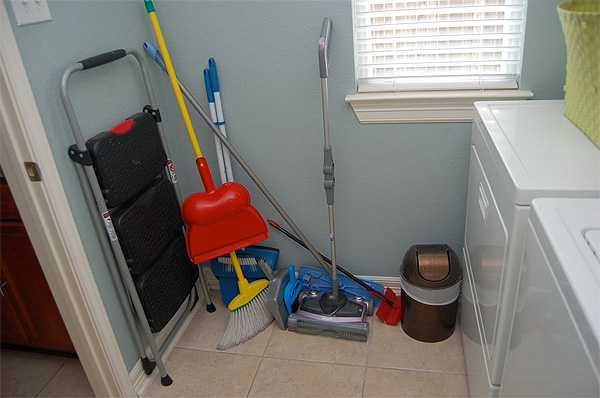
Putting hooks on the wall was too humdrum for Angela. So she stapled chevron-patterned cloth
to a rectangular pegboard (2-by-4-ft., $30); screwed the pegboard to a frame, and laid out her
brooms, dustpans, and baskets on the board before poking holes in the fabric for hooks.
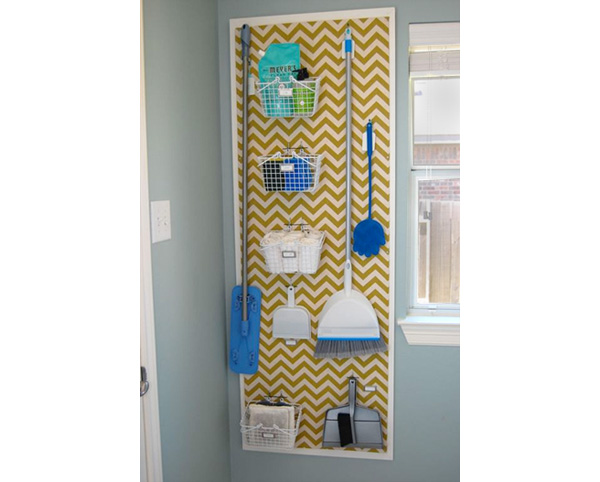
The pegboard is the “jewel” of Angela’s laundry room, which made the rest of space look even
sadder. So, she decided to spruce up the shelves, which were two lonely planks piled with
plastic bins, cleaning supplies, and an iron.
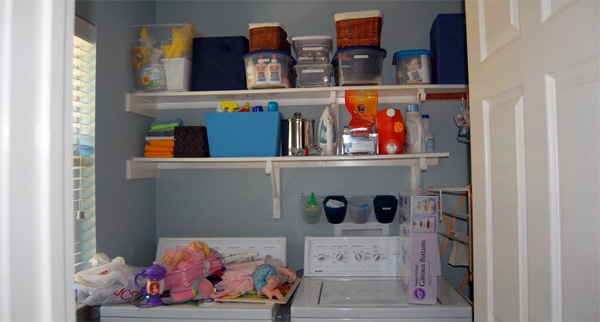
First, Angela added a low shelf for more storage space. Then, she covered cardboard with that
pretty chevron fabric to make inserts that gave her clear plastic bins a dash of style.
She chose green-and-white bins and baskets (6.5-qt. bins; 8 for $28) to match the fabric and
unify the room, and affixed labels that are fun and functional
.
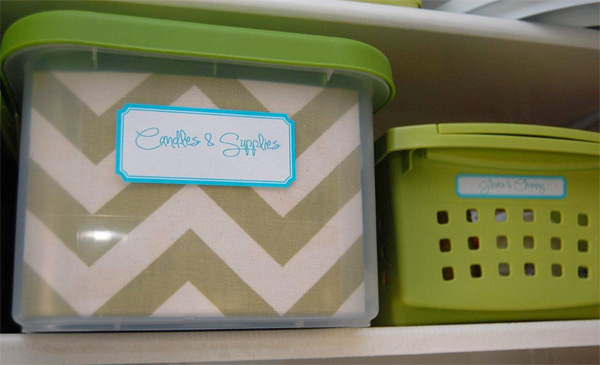
The result? A happy, mood-elevating laundry room with a place for everything (and everything in
its place).

For more inspiration, check out our other laundry room projects: A Drying Rack to Die For and Perfect for Organizing Laundry: A Dresser Made of Laundry Baskets.
Read more: http://www.houselogic.com/blog/laundry-rooms/cleaning-storage-pegboard/?nicmp=social&nichn=widgets&niseg=BoxLayout#ixzz2LYrDoFF2
Open House
Presenting an open house on February 23rd from 11 am-2 pm. Please stop and come view this lovely home.
Friday, February 1, 2013
New Kitchen, I think so!!
Reimagining the Kitchen: Trends for 2013
- Published: January 30, 2013
- By: John Riha
Today’s kitchen is a quick-change artist that adores families and loves simplicity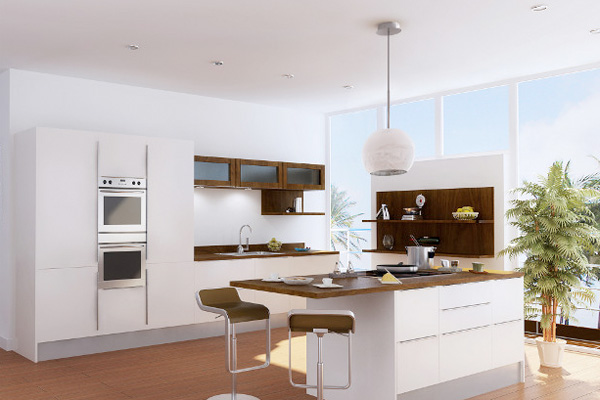
What looks like a hanging lamp is actually the Sorpresa Sphera range hood. Image: Best
If you’re looking to remodel your kitchen, we’ve got good news and bad news.
First, the good stuff. According to trend experts Lita Dirks and Dominick Tringali, you don’t
First, the good stuff. According to trend experts Lita Dirks and Dominick Tringali, you don’t
have to shell out major cash to add space. Instead, look to expand what you already have. Vault
your ceiling, add windows, squeeze in clever storage ideas. Make the space work harder, not
bigger.
Plus, relax. Casual kitchens are trending, with doo-dads and gee-gaws (think elaborate trim
and vent hoods that look like medieval castles) going away, and simpler, sleeker designs
coming on strong.
Speaking on kitchen trends at the 2013 International Builder’s Show in Las Vegas, interior
designer Dirks and architect Tringali teamed up to describe the new American kitchen as one
piece of a larger, open floor plan.
It’s all part of a new kitchen gestalt that Dirks describes as the “prep-eat-play” triangle, with
flexibility and casual living as key ingredients. The notion tosses the kitchen into a design
blender along with living, dining, and family rooms, and frappes everything into communal
happiness.
Example: You can eat at a comfy banquette, or in front of the TV (don’t tell your child-
development counselor), or in the breakfast nook, or you can belly up to the island. No rules!
The bad news (OK, it’s not that bad) is that we’ve heard some of this before. Open floor plans
The bad news (OK, it’s not that bad) is that we’ve heard some of this before. Open floor plans
have been around since the moon landing and yes, we like them. A lot. What we really have
here is affirmation — and freedom to create kitchens that are less ornate and yet have more
personality.
Just like you.
Of course, Dirks and Trengali definitely have the pulse of today’s home owner and offer some
great takeaways. We’ve combined their goodies with our own kitchen trendspotting for 2013. If
you’re planning a kitchen redo, here’s what you need to know:
Contemporary kitchens are In. Specifically, they’re getting simpler and more modern, with
less elaborate detail and trim. In fact, the National Kitchen and Bath Association reports that in
its annual survey of kitchen designers, “transitional” design — meaning a simple, more modern
aesthetic — has surpassed “traditional” as the preferred design for the first time in the
association’s history.
Kitchen cabinets are dark, or white. Darker, furniture-like finishes are popular, but so is pure
white. The middle ground — think natural oak — is going away. Dark finishes help the kitchen
integrate into the overall scheme; pure white is the ultimate accent color that readily
complements the rest of the living area.
Islands rule. Kitchen islands are becoming more multi-dimensional, serving as food-prep
areas, snack stations, wine storage, and display cabinets for objets d’art. Also, they’re
essential for directing traffic flow within an open floor plan, channeling guests toward comfy
seating areas, for example. Small kitchen? Go with a rolling cart that’s there when you need it.
Countertop revolution. Say hi to porcelain and ceramic slabs that look like stone, wood, and
fabric, says Jamie Gold, a California designer. The product is made from clay, quartz, and
feldspar that’s subjected to high heat — just like regular tile. Unlike other engineered
countertops, this product doesn’t use cements or resin binders. It’s not readily available in the
U.S. yet.
Appliances are disappearing. In the past, we loved our commercial-style kitchen appliances
that made us look like we really knew how to cook. Now, appliances are hiding behind wood
panels and faux veneers so they integrate better with the overall living space. New finishes,
such as GE’s slate and Whirlpool’s Ice White, are bucking the stainless steel trend, but don’t
bet on stainless going away anytime soon — it’s still hot.
and high-tech faucets are au courant. Other possibilities include:
- Stylish vent hood.
- Espresso machine.
- One-of-a-kind tiles as accents on kitchen backsplashes and countertops.
Glass finishes. Glistening glass is popping up everywhere in the kitchen, especially glass tiles
installed as backsplashes. Applying clear glass panels over walls painted soft colors gives a
deep sheen that harmonizes with today’s contemporary looks. Bonus: It’s easy to
should have an outdoor doppelganger close by, available through wide glass doors.
Read more: http://www.houselogic.com/blog/kitchens/kitchen-trends-2013/?
nicmp=social&nichn=widgets&niseg=BoxLayout#ixzz2JgOBAf7U
Wednesday, January 16, 2013
A home of their own.
Tiny houses may solve a big problem for adults with developmental disabilities: A home of their own.

A small cottage like this one could be perfect for a disabled adult to live in. Image:
We’re fascinated with tiny houses, those 85- to 500-sq.-ft. mini-homes that make great
granny pods, teen rooms, and cozy places for the couple that has (almost) nothing.
But it occurred to me that tiny houses also might be perfect for some developmentally
But it occurred to me that tiny houses also might be perfect for some developmentally
disabled adults who crave a home of their own, but also need supervision from
parents or caregivers.
I ran the idea past my cousin Karen Kaye-Beall, executive director of the Foundation
I ran the idea past my cousin Karen Kaye-Beall, executive director of the Foundation
for Autism Support and Training, and the mother of two adult children with autism —
Amelia, 21; and Tyler, 18.
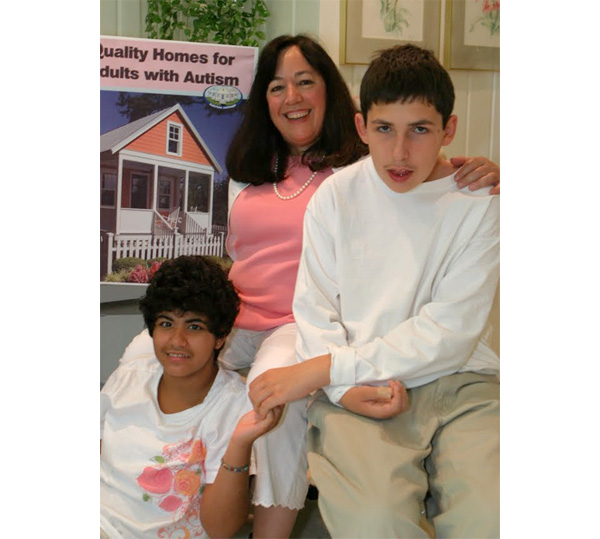
Credit: Karen Kaye-Beall
For the last 20 years, my cousin has worried about where and how Amelia and Tyler
will live when they are adults, especially after Karen and her husband, Tom, are no
longer able to care for them.
“It’s always in a parent’s mind,” she says. “How will they be independent? How will
“It’s always in a parent’s mind,” she says. “How will they be independent? How will
they live?“
Tiny houses may be an answer. Here’s why:
People with autism rely on predictable routines and environments to navigate life. Tiny
homes provide a place for everything, and everything in its place, a big part of the life
skills training that Amelia and Tyler received growing up.
Many people with autism have issues with sound — sounds they make that disturb
others, and sounds others make that disturb them. A detached tiny home eliminates
the adjacent walls with scant soundproofing, affording everyone some quiet.
Many people with autism are not able to hold jobs, and Social Security benefits are not
enough to pay for decent rentals in nice neighborhoods, Kaye-Beall says. Tiny
homes, which typically sell for between $25,000 and $70,000, are economical
alternatives.
Tiny homes can give some people with developmental disabilities a “charming” place
to call home, Kaye-Beall says. “This is my house — with little windows and shutters
and a tiny front porch. It’s my home. People with disabilities want that, too.”
If the idea appeals to you, check out these pictures of a variety of tiny homes.
If the idea appeals to you, check out these pictures of a variety of tiny homes.
Read more: http://www.houselogic.com/blog/home-thoughts/housing-for-disabled/?
nicmp=social&nichn=widgets&niseg=BoxLayout#ixzz2I9XTyn2u
Subscribe to:
Posts (Atom)

